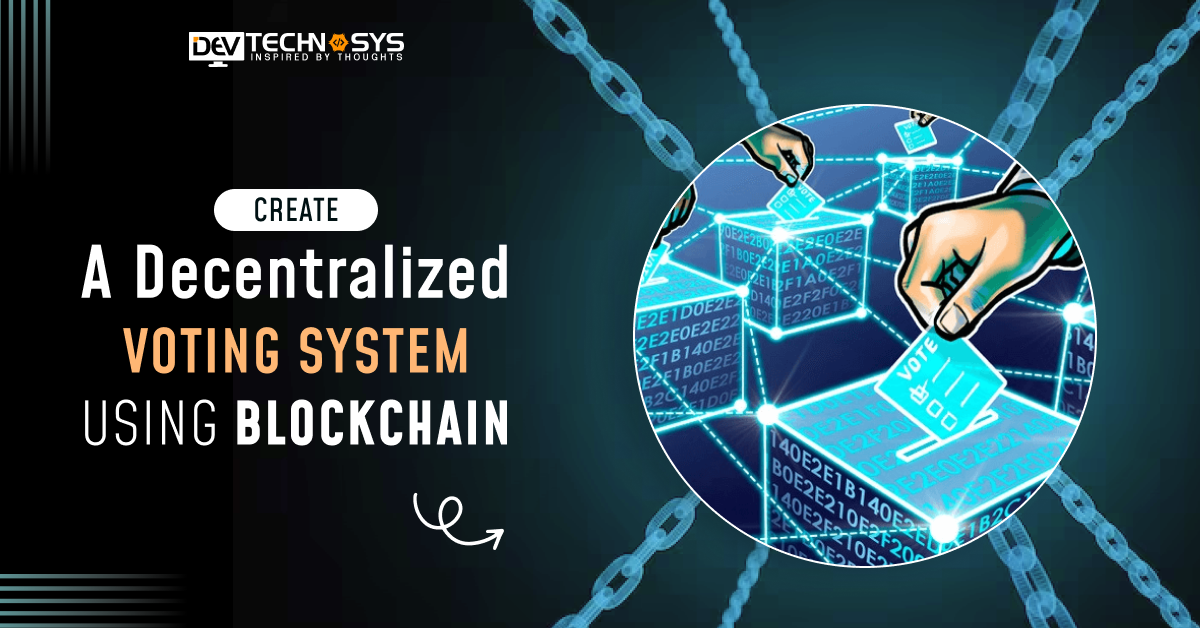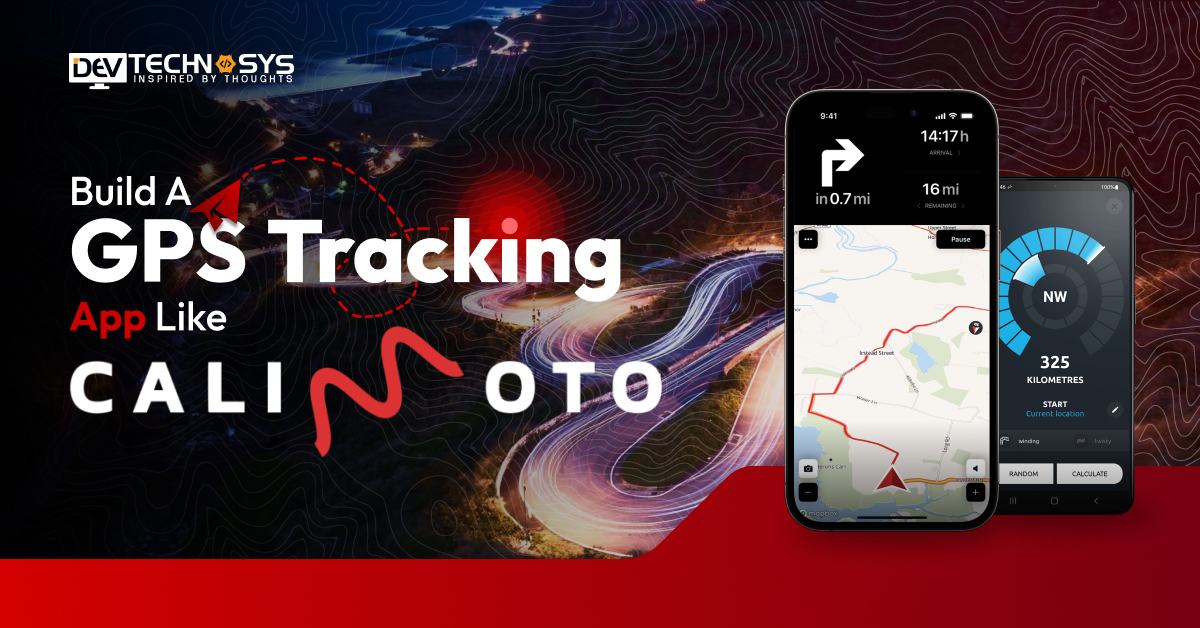“Give voting accuracy with a Decentralized Voting System using Blockchain.”
Traditional voting methods have been used since ancient times. But, they require a lot of manual effort for management and counting of votes. The idea to create a decentralized voting system using blockchain has revolutionized the way the voting has occurred. It reduces human interference and increases efficiency with high authority.
The use of blockchain based voting systems in the current governance industry helped people and officials in a sophisticated manner. The record of votes can easily be kept in large numbers. Additionally, the counting process can be performed without any delay.
So, if you want to build a similar blockchain voting system for your business, then it is important to study various topics. In this blog, you will get everything. Let us go!!
What is a Decentralized Voting System?
Without depending on centralized authorities, a decentralized voting system makes use of blockchain or other distributed technology to enable safe, transparent, and impenetrable voting procedures. By guaranteeing that votes are entered into an unchangeable ledger, it offers confirmation and removes the possibility of fraud or manipulation.
Because these systems are usually anonymous and encrypted, they give users more privacy and control over their votes. Hiring a Hyperledger blockchain development company is helpful for governance, elections, and decision-making in decentralized organizations such as DAOs. They leverage decentralized networks to improve accessibility and trust.
How a Decentralized Voting System Works?
Blockchain technology is used in a decentralized voting system to enable safe, transparent, and verifiable voting without the need for centralized authorities. It guarantees that votes are unchangeable, traceable, and unaltered.
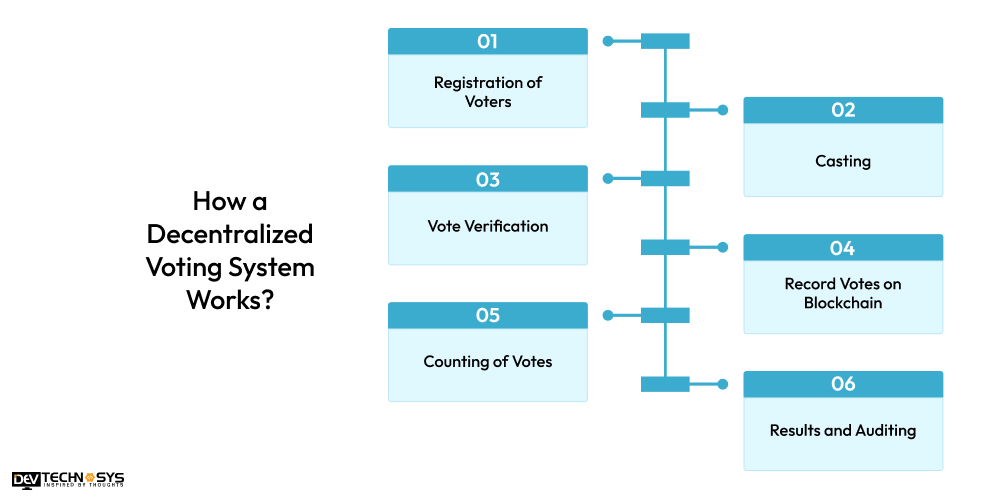
1. Registration of Voters
Eligible voters create a digital wallet or identity in order to register in a decentralized voting system. This procedure makes sure that only people who have been validated can cast ballots.
2. Casting
Voters can use a smart contract or dApp connected to the blockchain to cast their ballots after registering. To protect voter privacy, each vote is encrypted and linked to the voter’s digital identification.
3. Vote Verification
The network uses consensus techniques like Proof of Stake and Proof of Work to validate votes. It is necessary to approach an OTC crypto exchange development company who can guarantee that the votes are authentic and haven’t been tampered with or repeated.
4. Record Votes on Blockchain
Every legitimate vote is timestamped and permanently recorded on a blockchain ledger. Blockchain’s decentralized structure guarantees that once a vote is recorded, it cannot be changed or removed.
5. Counting of Votes
The blockchain uses smart contracts to automatically count the votes when the voting period is over. There is no need for hand counting because every vote is safely recorded on the ledger.
6. Results and Auditing
Complete transparency can be ensured by a dApp development company who can easily publish the voting results on the blockchain, where anybody can see them. The ledger allows participants or auditors to independently confirm the findings.
Market Stats For Decentralized Platforms
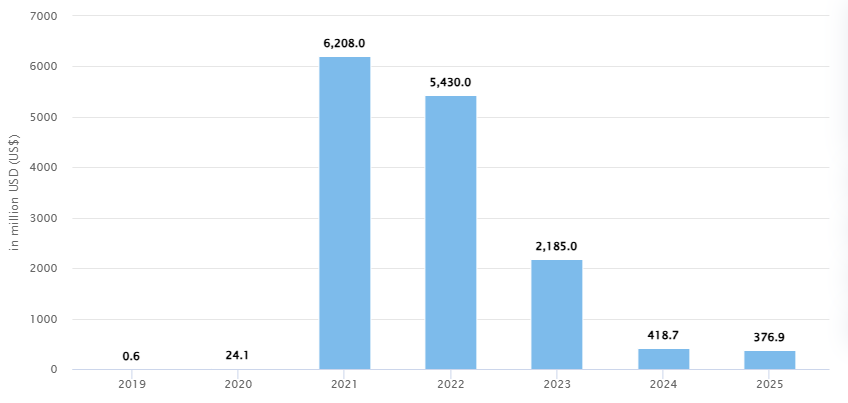
- By 2025, it is anticipated that the DeFi market will generate $376.9 Million for the nation.
- It is anticipated to expand at a rate of 68% CAGR between 2025-2032, reaching a total estimated value of $376.9 Million by the end of the tenure.
- In 2025, the DeFi market is expected to generate an average revenue per user of $7.0.
- Compared to other countries, the United States has the largest DeFi market revenue, with $71,990 Kin 2025.
- It is anticipated that the DeFi market would have 56 Million users by 2025.
- By 2025, the user penetration rate is anticipated to have increased to 69%from its 2025 projection of 0.69%.
- The United States is at the forefront of the global DeFi business thanks to its creative blockchain initiatives and strong regulatory environment.
Key Features of Decentralized Voting System
Blockchain technology is used in a decentralized voting system to guarantee safe, transparent, and unchangeable elections. With their many benefits, including immutability, accessibility, and anonymity, these technologies are transforming the way that voting is done.
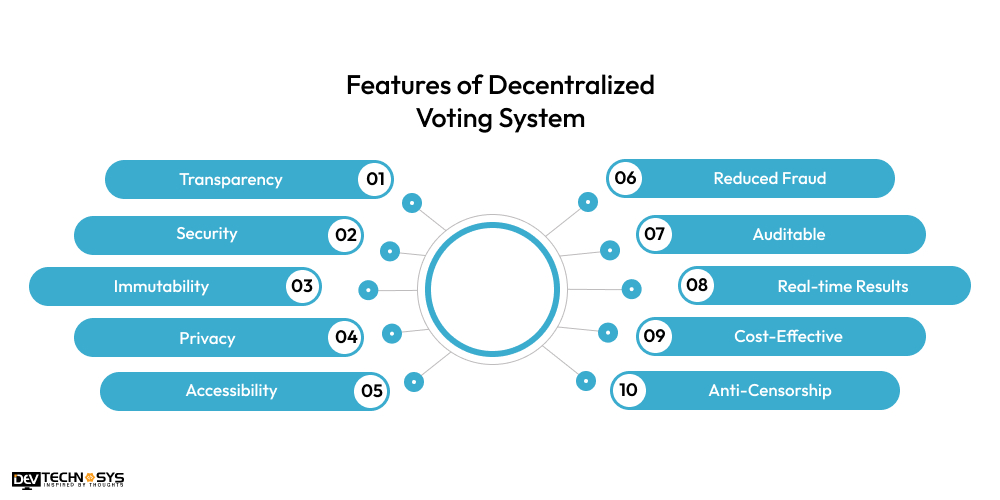
1. Transparency
Every vote is documented in a publicly available ledger thanks to the blockchain, which makes it possible for anybody to confirm the procedure. This openness dispels worries about manipulation or covert intentions.
2. Security
Votes are extremely safe from fraud or hacking since they are encrypted and kept on the blockchain. The system is more resilient because of its decentralized structure, which lowers the possibility of a single point of failure.
3. Immutability
A vote cannot be changed or removed after it has been cast and recorded on the blockchain voting example. The integrity of the voting procedure and outcomes is ensured by this immutability.
4. Privacy
Encryption protects voter anonymity, enabling people to cast ballots without disclosing their identities. The pseudonymous feature of blockchain guarantees the confidentiality of votes.
5. Accessibility
Anyone with a digital identity and internet connection can take part in a decentralized system, regardless of where they live. You can create a centralized crypto exchange like Bitstamp to facilitate this feature to users.
6. Reduced Fraud
There is a far lower chance of vote manipulation, duplicate voting, or phony votes when middlemen are removed and cryptographic techniques are used. A trustless environment is guaranteed by the decentralized design.
7. Auditable
The voting procedure is completely auditable because every vote is documented on the blockchain. Without requiring access to centralized servers, participants or other parties can independently confirm the results whenever they want.
8. Real-time Results
Without the delays usually associated with traditional voting systems, votes are counted automatically as they are cast, yielding results in real time. This makes the electoral process faster and more effective.
9. Cost-Effective
Decentralized voting lowers operating expenses by doing away with middlemen, documentation, and physical infrastructure. Additionally, it does away with the necessity for costly in-person polling places and election personnel.
10. Anti-Censorship
A vote cannot be censored or prevented from being recorded by a single authority because it is decentralized. By ensuring that all qualified votes are counted, this promotes inclusive and justice in the process.
What Are The Steps to Create a Decentralized Voting System Using Blockchain?
At this point, we should now understand how to create a decentralized voting system using blockchain. Let us study generalized development steps answering to different questions:
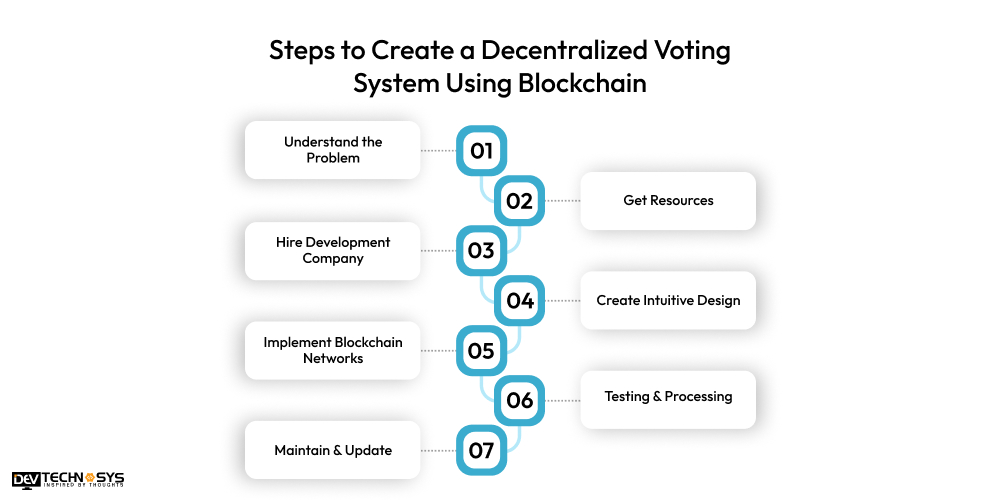
1. Understand The Problem
First, you should start by outlining the main issues with the voting process. Determine problems such as inadequate accessibility, fraud, and tampering that you may face during the decentralized cryptocurrency exchange development.
Recognize what is needed to guarantee voter security, privacy, and openness. Examine the legislative and regulatory structures pertaining to elections. Clearly define the decentralized voting system’s objectives.
| · What is the problem in the traditional voting system?
· Is Blockchain capable of changing the voting process? · Study different use cases related to the e-governance sector. |
2. Get Resources
Gather the platforms, frameworks, and technological tools required to create the blockchain based voting system. This entails deciding on a blockchain network and making sure that pertinent programming languages are available.
Compile software and hardware infrastructure, like decentralized nodes or cloud storage. Make sure the members of your team are knowledgeable with blockchain technology. Obtain adequate budgetary support and funding.
| · What resources are necessary for developing decentralized voting systems?
· Can I make a blueprint of the development program? · Mention different aspects like budget and requirements. |
3. Hire Development Company
You can choose a reputed blockchain app development company that specializes in creating safe, decentralized apps by doing your homework. Make sure the team is aware of the objectives, technical requirements, and legal requirements of your project.
Work together to set precise deadlines and objectives. Clearly define the team’s roles and duties. Throughout the project, keep lines of communication open to get continuous input and make any revisions.
| · How to choose the best decentralized crypto app development company?
· Discuss important things like tools and features. · How can I manage the cost by using Blockchain? |
4. Create Intuitive Design
Provide an intuitive user interface so that voters can access and utilize the voting system with ease. To serve all populations, prioritize accessibility, security, and ease of use. The design should be as simple as possible while maintaining security and privacy measures.
Verify desktop and mobile compatibility to use blockchain for electronic voting systems. Get input and usability enhancements by testing the design with prospective users.
| · Which design is suitable for electronic voting systems?
· Should I use AI tools for application designing? · How to ensure that the designing process is cost-effective? |
5. Implement Blockchain Networks
Invest money to create the blockchain network that will be used to store voting data in a decentralized, unchangeable format. To safeguard and automate the voting process, use smart contracts. To safeguard voter identities and ballots, make sure data encryption is in place.
Use cryptocurrency development services to incorporate real-time vote validation and verification. Test scalability to ensure error-free and timely handling of large-scale elections.
| · What is the use of APIs in the voting system?
· Which algorithm is suitable to keep voting records safe? · Study database model and integrating with blockchain. |
6. Testing & Processing
To find and fix any possible problems, weaknesses, or flaws in the system, do thorough testing. Model real-world election conditions, such as high voter turnout, network outages, and data integrity. Conduct security audits to guarantee transparent and impenetrable voting.
Verify the system’s responsiveness and scalability by testing the user interface. Use a decentralized voting platform based on Ethereum blockchain for testing feedback to enhance overall functionality.
| · How to test blockchain voting systems?
· What are the ways to process electronic voting systems? · Partner distributors to promote the decentralized voting system? |
7. Maintain & Update
Businesses must make sure the system is continuously monitored for security and performance after it has been implemented. Update smart contracts by using crypto wallet app development services to account for vulnerabilities or new developments.
Troubleshoot any problems and offer users continuing technical help. Maintain system conformity with changing legal and regulatory requirements. Schedule regular upgrades to add new features and improve the system.
| · How to maintain e-voting systems regularly?
· What are the mandatory feature updates? · Do I have to spend extra for software maintenance? |
Important Benefits of Decentralized Voting System Development Using Blockchain
Blockchain-powered decentralized voting guarantees safe, transparent, and impenetrable elections. By boosting accessibility and trust in democratic processes, this invention has the potential to revolutionize the voting process.
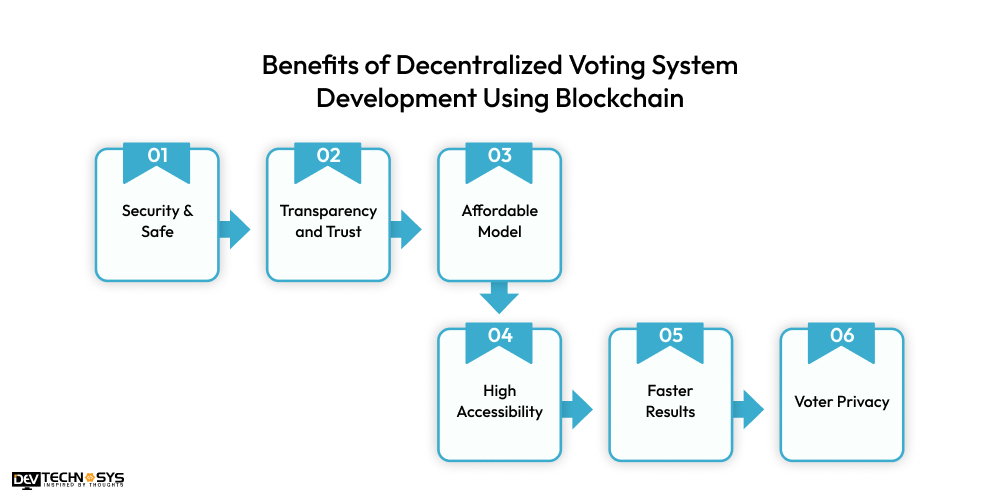
1. Security & Safe
Votes cannot be changed once they are cast thanks to blockchain’s unchangeable ledger, which greatly lowers the possibility of fraud or hacking. Because every vote is kept in a cryptographic chain, tampering is nearly impossible. You can easily create decentralized e-voting systems based on the blockchain technology to ensure that the electoral process is fair.
2. Transparency and Trust
Blockchain makes it possible for all transactions (votes) to be publicly and transparently recorded, providing outcomes that can be verified. Because everyone can audit the process, this transparency promotes public trust. It removes the possibility of covert vote tampering or backdoor manipulations.
3. Affordable Model
It eliminates the need for labor-intensive procedures and physical infrastructure by digitizing and automating the voting process. It reduces the expenses related to auditing and administering elections. Governments can preserve election integrity while saving a lot of money.
4. High Accessibility
People can safely cast their ballots from any location with an internet connection, increasing turnout, particularly among populations who are distant or incapacitated. Businesses must contact a Solana blockchain development company to ensure supporting a broad variety of devices. It eliminates obstacles to actual polling places.
5. Faster Results
Election results are determined more quickly thanks to the instantaneous recording and real-time tallying of votes. The use of blockchain for voting removes delays in reporting and traditional manual counting. Results are accessible nearly instantly after polls close because to blockchain’s rapid data processing.
6. Voter Privacy
Blockchain methods secure voters’ identities while confirming their eligibility through encryption. The anonymity of voters is preserved without sacrificing the legitimacy of their ballots. Concerns about coercion or intimidation during the voting process are addressed by this privacy protection.
What is The Cost to Build a Decentralized Voting System?
Smart contracts, blockchain technology, and secure user interfaces are all used in the construction of a decentralized voting system. The intricacy and level of skill needed can all have a significant impact on the price. The main elements affecting the total cost of development are listed below.
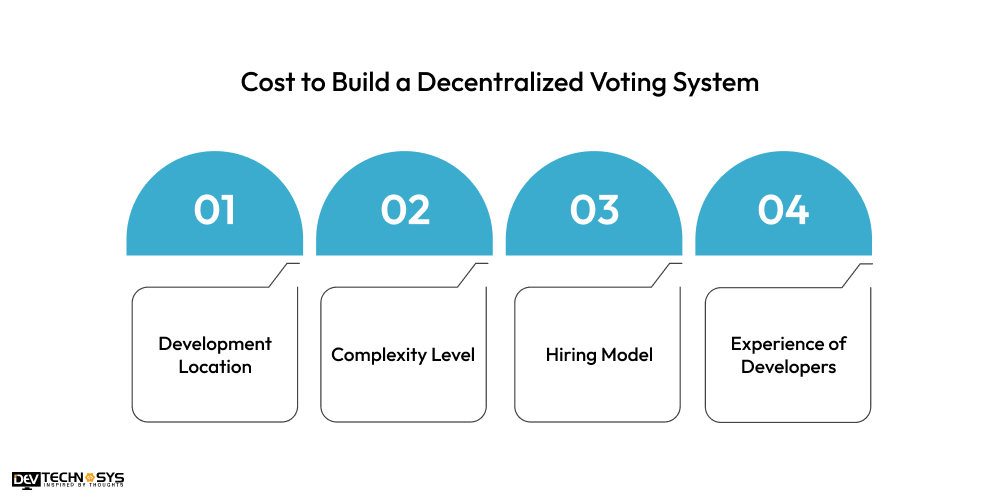
1. Development Location
The development team’s geographic location has a significant impact on the blockchain app development cost. Development can be substantially more costly in areas with high labor expenses, like Western Europe or North America. On the other hand, outsourcing to nations like Eastern Europe or India can reduce expenses without sacrificing quality.
Location Factor |
Estimated Cost (Hourly) |
| USA | $25000-$30000 |
| Australia | $20000-$25000 |
| India | $5000-$12000 |
| UK | $15000-$20000 |
| UAE | $8000-$15000 |
| Brazil | $12000-$16000 |
2. Complexity Level
The cost of the voting mechanism is directly impacted by its complexity. A small-scale, straightforward voting system may be less expensive to create than a fully functional, highly secure, scalable, feature-rich system. The difficulty is increased by features like real-time results, multi-signature wallets, and sophisticated encryption.
App Classification |
Development Time |
Estimated Cost |
| Simple | 2-5 months | $5000-$10000 |
| Moderate | 5-8 months | $10000-$15000 |
| Complex | 8-12 months | $15000-$20000 |
| Premium | More than 12 months | $20000-$25000 |
3. Hiring Model
The cost to hire blockchain developers highly influences the cost of development. Expenses for hiring a full-time in-house staff could include overhead, perks, and compensation.
As an alternative, outsourcing or hiring independent contractors can save money, but there may be coordination and quality control issues. Another feasible option is the hybrid approach, which involves outsourcing development.
Hiring Factor |
Estimated Cost |
| In House Team | $5,000-$8,000 |
| Full-Time Freelancers | $3,500-$5,000 |
| Developer Outreach | $8,000-$15,000 |
4. Experience of Developers
Because of their specific skills, experienced developers with knowledge of blockchain and smart contract creation usually demand premium prices. Long-term risks are decreased by developers that have a track record of creating scalable and secure systems. Although younger developers could be less expensive, implementation delays or problems could result from their inexperience.
Team’s Expertise Level |
Cost Estimation (USD) |
| Junior/Entry-Level | $8000-$12000 |
| Mid-Level/Experienced | $12000-$16000 |
| Senior/Expert | $16000-$20000 |
| Professional | $20000-$24000 |
How to Earn Money From a Decentralized Voting System?
A decentralized voting system’s efficiency, security, and openness can lead to the creation of many revenue sources. These platforms provide governments, businesses, and developers with creative methods to make money off of their technology.
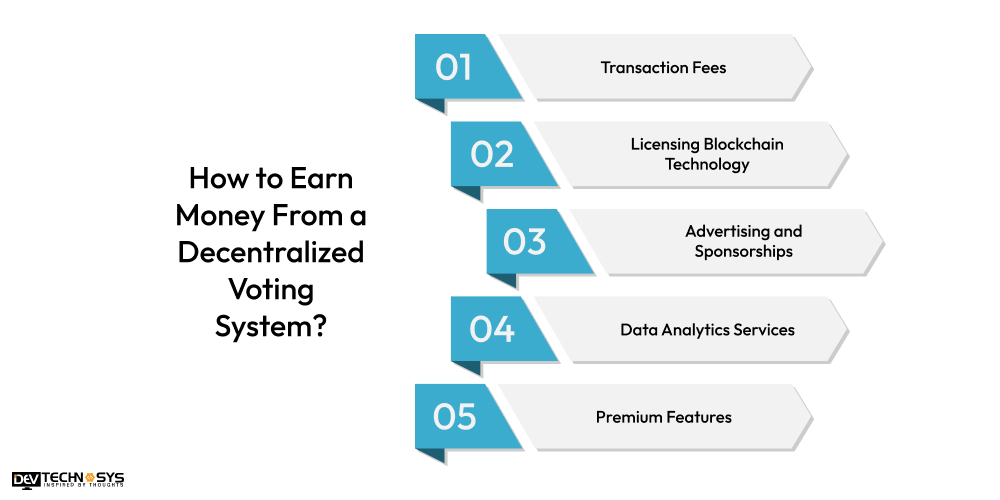
1. Transaction Fees
There may be a tiny transaction charge associated with each vote that is executed on the blockchain. Over the course of extensive elections or voting operations, these expenses may mount up. The platform can provide a steady income stream by collecting a small fee for each vote.
2. Licensing Blockchain Technology
Blockchain voting systems are able to license their technology to governments. You can create a smart contract on blockchain permitting other organizations to use the system via these licensing agreements. With more institutions implementing the technology, this strategy generates continuous revenue.
3. Advertising and Sponsorships
Platforms can sell advertising space to companies aiming to reach interested audiences during elections or voting activities. Voting systems are a desirable alternative for advertisers since they frequently draw a sizable number of participants. Institutional sponsorships can increase income prospects even more.
4. Data Analytics Services
It provides stakeholders with anonymised data analytics services. Research organizations or political campaigns might benefit from demographic studies, engagement indicators, and insights into voter behavior. Selling these reports or data can generate extra income.
5. Premium Features
Premium features like sophisticated security choices, personalized voting interfaces, or comprehensive auditing capabilities can be provided by blockchain voting platforms. A revenue layer is added to the base service by charging users or organizations for access to certain functionalities.
Let Us Summarize!!
Now, we are at the conclusion stage where businesses have already understood the process to create a decentralized voting system using blockchain. It’s time to study different concerns and follow a few precautions before development.
- First, stary by analyzing the ordinary voting system and mark errors.
- It is necessary to use authentic Solana blockchain development services to avoid loss of money and delay in the development process.
- Make sure that you are regularly monitoring the working and solutions.
- Check for necessary resources before making decentralized E-voting systems based on the blockchain technology.
- Execute applicable monetization models to generate income from the blockchain voting system.
If you are willing to push your business forward in the e-governance sector, then investment of money in the decentralized blockchain based voting system is crucial. So, that you can become a leader in this industry.
Frequently Asked Questions
1. What is a Decentralized Voting System?
Blockchain technology is used in a decentralized voting system to ensure safe, transparent, and impenetrable elections. It guarantees that votes are entered into an unchangeable ledger, which makes them impervious to fraud or manipulation.
2. What is the Decentralized Voting System Development Cost?
Decentralized voting systems usually cost between $10,000 and $100,000 to construct, depending on customization, security features, and complexity. The sum could rise much more with additional expenses for testing, audits, and compliance.
3. How to Build a Decentralized Voting System?
- Determine the voting system’s objective.
- Choose a blockchain platform, like Binance Smart Chain or Ethereum.
- Make smart contracts to manage the logic for voting.
- Create a user-friendly interface that makes it easy for people to register, vote, and see the results.
- Test the system thoroughly to find any weaknesses.
4. How Data is Secured in Decentralized Voting Systems?
- Votes are encrypted to preserve voter privacy by guaranteeing confidentiality.
- Votes cannot be changed or removed after they are cast.
- Because the system is distributed, there is less chance of hacking, manipulation, or censorship.
5. What are the Benefits to Create a Decentralized Voting System Using Blockchain?
- Blockchain ensures that the voting process is transparent by providing a log of votes.
- Votes cannot be changed eliminating fraud and guaranteeing the accuracy of the results.
- The system is more secure because of blockchain’s cryptography techniques.
6. How to Monetize Decentralized Voting Systems?
- Make money per use by charging nominal transaction fees for each vote cast.
- Use a subscription-based service to provide businesses or governments with premium benefits.
- Earn professional fees by offering implementation and consulting services.
